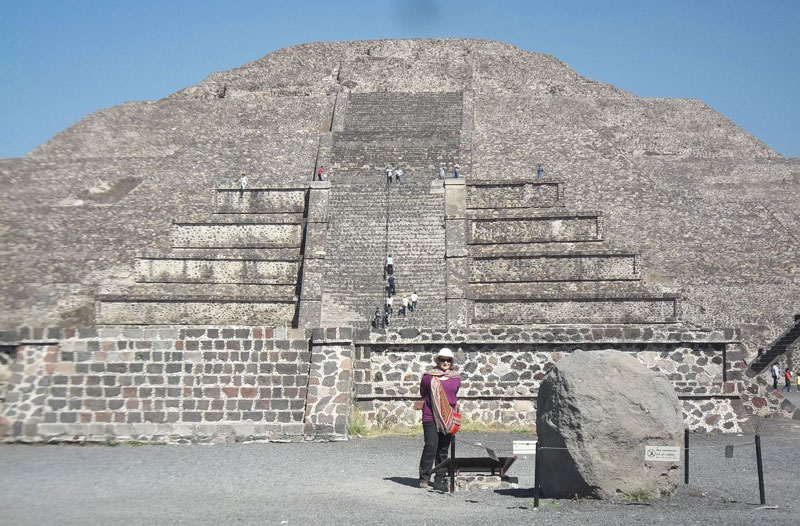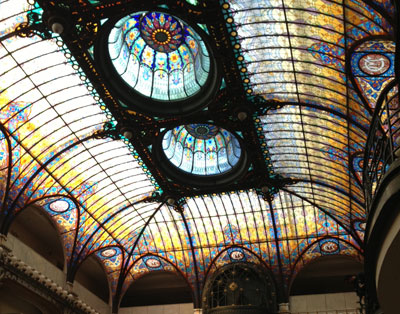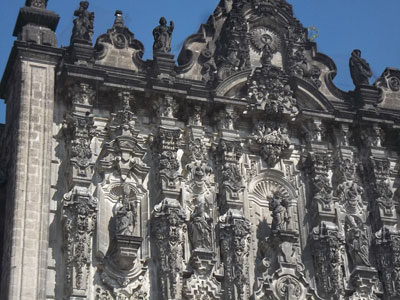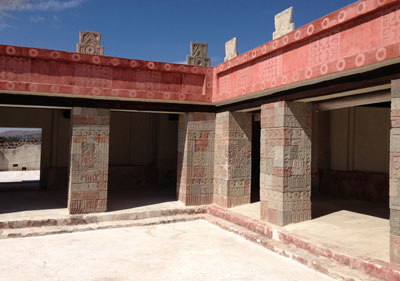Getting a feel for the local culture on an extended weekend in Mexico City
This article appears on page 46 of the April 2014 issue.
by Marvin Herman; Delavan, WI
Just as the blustery December winds of Wisconsin blew harder and the temperatures dipped lower, we embarked on an adventurous journey to the wilds of Mexico and Guatemala in 2013 to visit some ruins that my wife, Judy, had longed to see.
In Mexico City (officially, México, D.F.), our focus was the archaeological Aztec structures in and near the city.
Mexico City stay
Although the latter part of our trip would be a small-group tour led by an archaeologist and arranged by Maya Sites, our time in Mexico City was spent independently. International air was covered by points earned on our Chase® Sapphire Preferred card and cost the equivalent of $700 per person on Aeromexico.
Upon landing at Benito Juárez International Airport, we withdrew pesos from an ATM and purchased a taxi ticket from one of the many kiosks just inside the door that led to the outside of the airport terminal. The fare to our hotel was equivalent to about $18. Arranging for a taxi at the kiosk assures the traveler that he is getting a reliable taxi and is paying a proper fare to his destination.
Travelers are warned not to hail cabs in the street due to the incidence of kidnapping in Mexico City. We were told that there have been cases where the cab driver took the passengers to an ATM and forced them to withdraw funds, then kept the travelers overnight and repeated the withdrawal process in the morning before letting the hapless victims out in a remote and unsafe area of the city.
Our driver got us close to the entrance to the Gran Hotel Ciudad de México (Avenida16 de Septiembre No. 82), since there was construction on the road fronting the entrance. The street was also blocked by hundreds of police monitoring a protest by compesinos, indigenous people mainly from the agricultural areas of the country. (We heard conflicting rumors on what it was they were protesting.)
We had booked four nights in a junior suite facing the zócalo, or main plaza, at a cost of about $160 per night, including breakfast and an early-booking discount. The rack rate posted during our stay was more than double that. The large single room (No. 202), though not really a suite, was well appointed, with a large canopy bed and a flat-panel TV. Free WiFi was included, and there was a room safe.
From our window, we could see almost the entire zócalo and the giant Christmas tree set up there. The room was fairly quiet, since the protests had stopped and the construction noise had abated, but these noises would start again early each morning and last all day during our stay.
We had wanted that particular room location; we knew there would be noise, but we wanted to be in the midst of the action of the zócalo. Anyone who wants a quiet stay in this hotel should book a room at the back of the building on a higher floor.
Experiencing the city
In the morning, we crossed the zócalo on our way to Templo Mayor, an archaeological excavation of the Aztec ruin upon which Mexico City is built. After paying an admission fee of 57 pesos (about $4.30), we toured the ruin and the museum.
Judy found the ruin fascinating; I found it less so. Our next activity — riding the Metro — was more up my alley.
For three pesos (almost free), one can ride in one direction anywhere the system goes. Compared to other underground transportation systems we have ridden elsewhere in the world, this one was antiquated.
It was not possible to purchase tickets from a machine. We had to wait in a line to buy tickets from a live person.
The train cars were not the most modern, and they were extremely crowded. Passengers leaving the train were literally pushed out of the doors, though the people tried to be considerate of one another. There are just too many people for the system.
We traveled to the “Auditorio” stop, where we could walk to the best museum in all of Mexico: the National Museum of Anthropology (admission, 57 pesos). We walked our way from the first people in Mexico to the Mayans. The displays were breathtaking. They even had outdoor sections where temples uncovered as ruins in jungles throughout the country were depicted as they originally would have appearred.
As we walked back to the hotel, we realized that we hadn’t yet had lunch, and we were very hungry. We noticed people walking down the street eating what looked like pizza, so we stopped a lady to ask where she had purchased it. She gestured toward an arcade near the hotel. There, teams of two women each were selling garnachas, made by taking large tortillas of máiz negra (black corn) and covering them with white cheese and red and green salsa (20 pesos, or $1.50, each). They were fresh, delicious and quite filling.
Once up in our room and ready to relax for the night, we heard a roar from the zócalo that drowned out the protests. The Christmas tree was lighted and thousands of families had ridden the Metro to the zócalo to witness it.
The din of bells loudly tolling all around the plaza, and especially from the towers of the Metropolitan Cathedral, joined in creating a frenzied atmosphere the like of which I have never seen.
Lights on the buildings surrounding the zócalo were also turned on. Our hotel had lighted images of choir boys and candles. Other buildings had colorful lights marking the season and spelling out “Feliz Navidad” and “Feliz Año Nuevo.”
Teotihuacán
After breakfast the next day we met our driver, Cristian, arranged for by the hotel concierge the day before. Cristian Zarate (phone 044551491 1711, email transportemexico@hotmail.com) was punctual and friendly, knew some English and was a good driver in his late-model Nissan. He was to drive us to Teotihuacán, located an hour from our hotel.
The Metro doesn’t run to that site, and having a driver was the most efficient way to travel there. (You could also take the Metro to the public bus station and take a bus to the site — less expensive but also less reliable.)
The traffic in Mexico City was as dense as any we’d seen in our travels.
At Teotihuacán (57 pesos for admission plus 50 pesos for the car), we were given a map of the site showing the magnificent pyramids of the sun and the moon, both of which can be ascended, and the long street leading to the latter, called Avenue of the Dead. There is also a fine museum containing artifacts found at the site.
We spent over 3½ hours at the site, by which time we were pleased to see Cristian waiting for us. It took almost two hours to drive back to our hotel.
The cost of the driver’s services for the day was $90.
Mixing with the locals
On the street behind the hotel, we noticed a small restaurant bustling with trade for its huaraches, small ovals of masa filled with fried, fatty pork bits, beans, onions, tomatoes and salsa (25 pesos). Unable to resist the aroma, we each had one.
I admit that this is not health food, but, though the guidebooks all contain prohibitions against eating food of this nature, we had no choice. It was simply irresistible!
To fight off digestive ailments while traveling, we each take two Pepto-Bismol® tablets each morning so we don’t have to deny ourselves the local food as the locals eat it. However, this is not offered as advice to everyone. I must admit, the result of such conduct is not always pleasant.
Back in our hotel room, full of food and content with the day, we lay down in the warmth of the late afternoon and fell asleep. After a time, I was awakened by a loud roar from the crowd in the zócalo. I went to the window and saw people milling around the square, some with small children and others with gifts wrapped for the approaching holiday.
I was drawn down to the street on that Saturday evening and I felt the vibe of happiness of the people.
A young woman dressed as a sexy Santa had a stool for the young children to sit on and impart their Christmas desires as their parents listened discreetly.
Another guy in the crowd was dressed in a robot suit, amusing the children in the area. Colorful plastic rockets, filled with air, were tossed around.
McDonald’s was doing a brisk business at its outside counter selling ice cream cones for eight pesos (about 60¢) each. It was truly a special night.
A final day out
After breakfast the next morning, we scrapped our idea of visiting the floating gardens of Xochimilco, deciding instead to get away from the crowds for a while and take a stroll through tranquil Alameda park. We took the Metro three stops from the “Zócalo” stop to “Hildago,” near the western edge of the park.
We found the park to be the serene locale that we expected. We slowly walked back along the shaded paths, stopping to rest on the benches surrounding small plazas, watching the chess players as well as the joggers ambling by.
Exiting the park, we walked to the shopping street, Avenida Francisco Madero, closed to vehicular traffic, where we browsed in the stores and made some purchases.
We also stopped to see the Iglesia de Jesús Nazareno, a church near Hospital de Jesús Nazareno, which was built by order of Hernán Cortés in 1524 to treat his sick and wounded soldiers. The tomb of Cortés is located there. Behind the church is the place where Cortés met Moctezuma.
After a rest, we decided to have a meal at the widely recommended Hostería de Santo Domingo (Belisario Domínguez 72), walking distance from our hotel. We were seated on the restaurant’s main floor, which seemed to have a better feel than the upstairs section. A 3-piece combo played American music on guitar, violin and piano.
I had the specialty, stuffed pepper, and Judy had fajitas. Along with water and a beer, the bill came to 350 pesos plus 10% for service (around $32).
We noticed none of our countrymen at the restaurant, although NFL football games were being shown on the muted, flat-panel TV on the wall.
On the way back to our hotel, we visited the Metropolitan Cathedral at the far end of the zócalo with its richly ornate, Baroque façade and twin bell towers. At the altar was a crucified Christ depicted as an Indian with a silver crown of thorns upon his head.
Later in the evening, we were stunned by a cacophony of bells and sirens emanating from the zócalo, heralding the start of a Christmas parade presented by Coca-Cola for one of its largest markets. There were beautiful floats, dancers in lighted costumes, airborne polar bear and penguin balloons the size of small buildings and a breathtaking fireworks display.
The following day, we would leave Mexico City and fly down to Villahermosa for the next leg of our trip.
Although there may have been security warnings and other announced reasons to avoid this capital city, we were very pleased that we had visited. We would encourage independent travelers with an adventurous spirit to visit Mexico City.




